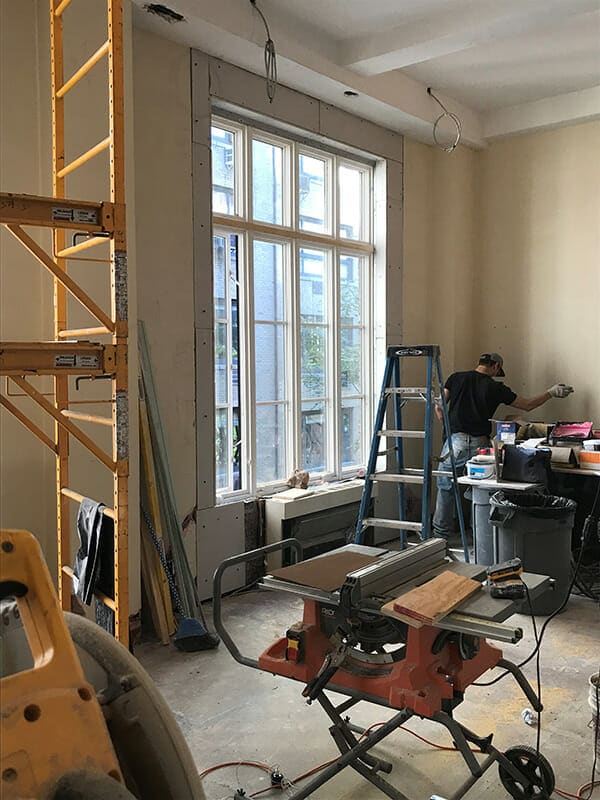
6 Steps to Selecting the Right Contractor
January 11, 2019
A really good contractor is critical to the success of your project. Without the right contractor, your exquisitely designed dream home risks becoming a nightmare. If you’ve never commissioned a co-op, condo or apartment, how do you go about selecting the right contractor for your project?
1. Understand who you are.
Architects approach projects in a particular way. We generally recommend a thorough and careful design period in which we document the entire design before construction begins. We give you the drawings, material samples, and time you need to understand what will be built before we start. Because this process is so detailed and organized, change orders and cost escalations from unforeseen problems are usually very limited – we typically see overages of less than 5% when a careful process is followed. For many clients, this process is ideal and meshes well with how they tend to approach other aspects of their lives.
The type of contractor for this approach is thorough and experienced, and generally has several staff both in the field and in the office who help to schedule trades, delivery of materials, and generally help the staff to deliver. Ability to stick to budgets, timelines, and plans is paramount.
That may not be your style, though. You may be more comfortable making decisions as the structure is being built, so you can easily visualize what’s at issue and what the outcomes might be. The “paper” design phase that is key to the architect’s approach may leave you frustrated and be something that you want to get through as fast as possible. This approach requires knowledge and flexibility, and comes with a certain amount of risk – which can be managed if you have the right people involved. This approach can require a different kind of contractor, and often the best outcome will be from a team that isn’t necessarily super organized, but is definitely trustworthy, affable and willing to absorb or negotiate in good faith through the unexpected.
2. Ask for referrals.
Your architect, friends, family, the building super, and the building manager are all good resources to mine for information. Be attentive to any complaints that are raised and try to understand why conflict, if any, occurred (it’s not always the contractor!). Direct references are good, indirect references are even better. If approached reasonably, most former clients will give a fairly honest recap of how their project went.
3. Look at prior work.
Try to look at examples of work done by the contractor on a scale similar to your planned work. After two or three years, is the work holding up? Does the AC work reliably, are the cabinets wearing well, do the doors operate smoothly, is the paint nice and neat, nothing requiring major repairs? Is the contractor still helpful with the inevitable odds and ends that do need repair – and if not doing them with his team, did the contractor help to find proper support?
4. Meet face to face.
As your architects, typically we will be working with your general contractor on a day-to-day basis while your project is being built. However, the GC’s contract is with you, and you pay the bills. You should meet the GC as well as his field representative before they are hired, just as you would with any substantial vendor. If there is anything about the GC or his team that leaves you questioning or worried, try to get to the bottom of it with your architect. The process of completing a project is difficult enough that you need to feel comfortable with your team and able to have difficult discussions if, or when, needed.
5. Ask lots of questions.
You should feel free to ask whatever questions are on your mind, the way the contractor answers you will help you build an understanding of how they will work with you and the rest of your team, some good things to ask:
How many people compose the project team?
Who from the team will be directly focused on your project?
Can I meet the foreperson and/or the project manager who will be at the site every day?
How long have they been with the company?
Who will be the main subcontractors?
How long has the GC been working with them?
6. Review – and make sure you understand – the contract.
It’s typically part of our role as your architects to review the GC contract with you and point out any issues or problems. But as the client and owner, it is a very good idea for you to read through the entire contract with us and with your contractor to make sure that you understand all of the provisions. This is also the case with the set of drawings that forms the basis for the contract – if you’re aware of what is and is not included in the scope of work, you won’t be surprised by misunderstandings later in the process.
Every building project hits some kind of snag, but if you go through these steps to establish clear expectations and a firm relationship with your contractor, you have a much greater chance of a successful outcome.
Looking for help defining your project needs? Contact us today for a complimentary assessment of your project.